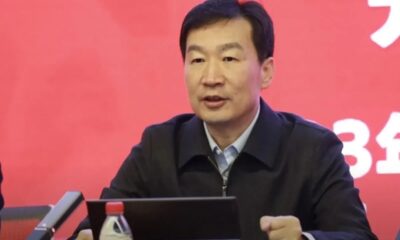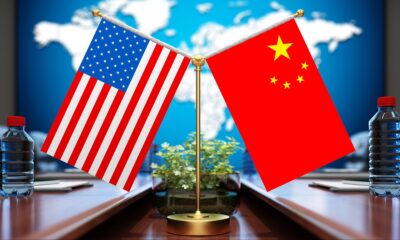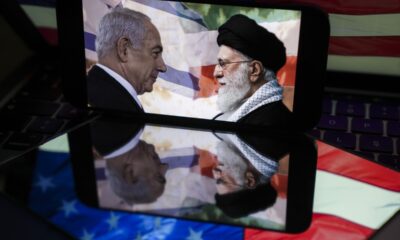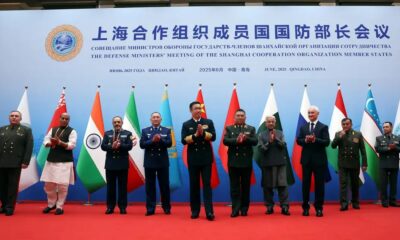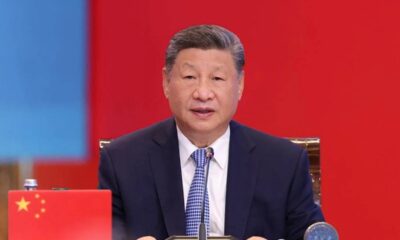Asia
How will the change of leadership in Vietnam affect foreign policy?

Observers say that despite the uncertainty in Hanoi following the death of long-serving leader Nguyen Phu Trong, China’s relations with Vietnam will remain largely stable.
Mr Trong, 80, who died last week after a long illness, was a prominent figure in Vietnam’s rapid economic growth and fight against corruption. He also spearheaded Vietnam’s ‘bamboo diplomacy’, which struck a delicate balance in the US-China rivalry.
In a rare visit to the Vietnamese embassy in Beijing last Saturday, Chinese President Xi Jinping spoke of their ‘deep friendship’ and praised Trong’s ‘outstanding contribution’ to relations between the two countries and their ruling parties.
The Chinese Communist Party also issued a condolence message hours after Trong’s death was announced, describing him as ‘a good comrade, a good brother and a good friend’. China’s No 4 official, Wang Huning, is leading a delegation to Vietnam to attend Nguyen’s state funeral on Friday (today).
Hanoi stressed the importance of its relations with Beijing, pledging to Chinese Ambassador Pham Sao Mai to ‘stick to the strategic choice and priority of developing friendly cooperation with China’, according to the official Xinhua news agency.
Zhang Mingliang, an expert on Southeast Asian affairs at Jinan University in Guangzhou, said Xi’s embassy visit showed that Beijing was relatively satisfied with the development of bilateral relations during the Trong era.
“Compared to relations during the oil rig crisis in 2014 and [former US President Donald] Trump’s state visit to Vietnam in 2017, Sino-Vietnamese relations have improved significantly since Hanoi adopted the concept of ‘community of shared destiny’ at Beijing’s request last year,” Zhang told the South China Morning Post.
“Compared to the high tensions with the Philippines in the South China Sea, Vietnam and China have managed to get along well without exaggerating their deep differences on regional issues,” he added.
Relations between the communist neighbours have been turbulent in recent decades, with clashes over the disputed Paracel Islands in the 1970s and a brief but bloody border war in 1979.
Zhang noted that relations also hit a low point during the 2014 diplomatic row over China’s placement of a deepwater oil rig near the Paracels, which was seen as a turning point in Hanoi’s relations with Washington.
“Under Trong’s rule, Vietnam has managed to establish at least a superficially friendly relationship with China. But at the same time, Vietnam’s relations with the US and Russia have reached unprecedented levels,” Zhang said.
“The purpose of all this is to keep China in check and ensure that Vietnam enjoys a favourable international environment and relatively stable relations with China, which are largely under Hanoi’s control. This may seem like an impossible task, but Trong’s Vietnam has managed to hedge its bets with the big powers,” he added.
Relations with China
Vietnam’s most influential leader since founding revolutionary leader Ho Chi Minh, Trong became general secretary of the ruling party in 2011 and secured a precedent-setting third five-year term in 2021. Trong also served as Vietnam’s president from 2018 to 2020.
Amid speculation that his health was deteriorating, Trong visited Beijing in October 2022, his first overseas trip since suffering a stroke in 2019, and the first foreign leader to meet Xi after securing a third term.
In the past 10 months, despite his illness, Trong has hosted both Xi and US President Joe Biden in Hanoi, and met with Russian President Vladimir Putin in June. Hanoi has also elevated Japan, India, South Korea and Australia to its highest level of comprehensive strategic partners.
Carl Thayer, professor emeritus at the University of New South Wales in Australia, told the South China Morning Post that Trong will be remembered for his 2015 trips to the US and Japan, which laid the groundwork for closer ties with the West.
“Hanoi’s relations with Beijing will remain ‘stable and friendly’ because Vietnam will not abandon its foreign policy of ‘peace, cooperation and development’,” Thayer said.
“China plays a special role in Vietnam’s foreign relations. It is Vietnam’s first comprehensive strategic partner and the only major power to be called a comprehensive strategic cooperation partner,” he said.
Analysts also pointed to Trong’s personal bond with Xi and the ties between the two communist parties, which over the years have acted as a counterweight in the turbulent relationship between Hanoi and Beijing.
As Vietnam has expanded its diplomacy and improved its relations with the United States, I think Trong has been able to convince Beijing that Vietnam is truly neutral and independent and that improving relations with Washington would not be to Beijing’s detriment,” said Southeast Asia expert Zachary Abuza, a professor at the National War College in Washington.
“This was possible because of Trong’s resolute communist ideology. He saw the world the way Xi Jinping does,” he added.
Abuza also noted that China has inter-party channels with Vietnam to ensure a constant flow of communication between senior officials, something the United States does not have.
Nguyen Khac Giang, an analyst at the ISEAS-Yusof Ishak Institute in Singapore, said Trong and Xi had a close relationship because of their shared commitment to Marxism-Leninism.
“This helped stabilise bilateral relations, especially during periods of tension over maritime disputes in the South China Sea, Trong also had a very positive view of China and admired the Chinese Communist Party, but took a pragmatic approach with them on many sensitive issues,” the analyst told the South China Morning Post.
Although Trong’s potential successors, such as President To Lam, may not have the same bond with Xi, “I don’t think this will greatly affect Hanoi’s ability to maintain good relations with China because the inter-party bond remains strong,” Giang said.
He said the bamboo diplomacy approach ‘is working well’ and Trong’s successor is unlikely to change it or its core policies ‘to prove his legitimacy as the rightful heir’, at least in the medium term.
‘No drastic changes in foreign policy’
A day before his death, Trong’s duties were temporarily transferred to Lam. Lam, 66, who became head of state in May, was previously Vietnam’s minister of public security and oversaw the anti-corruption campaign. The so-called ‘furnace of fire’ campaign has led to the dismissal of 40 members of the party’s central committee and dozens of army and police generals since 2016.
The removal of six of the 18 members of the Politburo since December 2022, including three of Vietnam’s top five leaders since March, has raised concerns about uncertainty.
Despite the political turmoil, Abuza said he expects ‘absolutely no change’ in Vietnam’s foreign policy, saying Hanoi will remain ‘scrupulously neutral’ and has deep economic ties with both China and the US and its allies.
Asia
Chinese navy chief and top nuclear scientist expelled from legislature

The chief of staff for the People’s Liberation Army (PLA) Navy, Vice Admiral Li Hanjun, and Liu Shipeng, the deputy chief engineer of the state-owned China National Nuclear Corporation, were removed from their positions in the country’s legislative body.
Li is the latest in a series of PLA generals and a handful of defense industry executives implicated in a widespread investigation within the military.
In a statement on Friday, the NPC Standing Committee announced, “The Navy Soldiers’ Congress has decided to remove Li Hanjun from his post as a representative to the 14th National People’s Congress.”
The Gansu People’s Congress also dismissed Liu Shipeng from his role as an NPC deputy.
Additionally, the Standing Committee revealed it had voted to remove Miao Hua, a former top general who previously oversaw the PLA’s ideological work, from the Central Military Commission (CMC), China’s highest military command body led by President Xi Jinping.
The removal of Li and Liu from their NPC memberships suggests they are facing serious disciplinary action.
China typically remains silent about purges within the military, and announcements from the NPC are one of the few indicators of such campaigns.
There is little public information available about Li and Liu, as both have worked in sensitive positions.
Before becoming the navy’s chief of staff, Li, 60, was the deputy director of the CMC’s Training and Administration Department. He was appointed to this role after serving for a year in the CMC’s Office for Reform and Organisational Structure.
In 2014, he was promoted to vice admiral upon his appointment as commander of the naval base in Fujian province, where Miao also spent a significant part of his career. At that time, he was the director of training at the China Naval Command College and was soon promoted to president of the school.
According to official media reports, nuclear scientist Liu was born into a family that “served China’s nuclear dream for three generations.”
As the deputy chief engineer at CNNC, which oversees all aspects of China’s civil and military nuclear programs, Liu also served as the Communist Party secretary and president of CNNC’s “404 base” in Gansu.
Covering an area of over 1,000 square kilometers, the base was established in 1958 and is the country’s first and largest nuclear research center. It played a crucial role in the development of China’s first atomic bomb in 1964 and its first hydrogen bomb three years later.
This secretive base is still considered a key hub for China’s nuclear deterrence and nuclear industry.
According to statements from provincial authorities, Liu was named “Gansu’s outstanding entrepreneur” in 2023.
Asia
China, US reach agreement on export controls

The Chinese Ministry of Commerce announced on Friday afternoon that Beijing and Washington have remained in close contact since the two-day trade talks in London earlier this month, confirming the details of a framework agreement.
“China will review and approve export applications for controlled items in accordance with its laws and regulations, and the US side will, in turn, lift a series of restrictive measures against China,” the ministry stated.
“We hope the US side will cooperate with China in line with the important consensus and conditions established during the conversation between the two presidents on June 5,” the statement continued.
On Thursday, US President Donald Trump said the US had “signed” a trade deal with China the previous day, without providing details.
“We signed the deal with China yesterday, right? We signed the deal with China,” Trump said at a White House event introducing a budget law. “With the China deal, we are starting to open up China,” he added.
He also mentioned that a “very big” deal, likely with India, would be signed soon.
Rare earth elements
Following the event, US Commerce Secretary Howard Lutnick told reporters that the US and China had signed an agreement codifying the terms decided upon in previous trade negotiations.
“They will deliver rare earth elements to us,” Lutnick said in a televised interview with Bloomberg, adding that if this commitment is fulfilled, Washington will lift its “countermeasures.”
Rare earth elements, essential for producing high-tech products, including those for the defense industry, were a major point of contention in the trade talks. China holds a near-monopoly on the supply of these minerals due to its massive share of global refining capacity.
Responding to a question on Thursday about rare earth exports, ministry spokesman He Yadong said China had approved a “certain number” of applications and would “continue to strengthen” the review and approval process for eligible applications.
He added that Beijing is willing to “strengthen communication and dialogue” with other countries on export controls and actively promote appropriate trade.
Lutnick also stated that the US plans to reach agreements with 10 major trading partners in the coming weeks. The deadline for countries to negotiate trade terms before higher tariffs are reinstated was July 9, following a 90-day suspension of import tariff hikes announced on April 2.
The two negotiating teams concluded the London talks by announcing they had agreed “in principle” on a “framework” that both sides would take home for their respective leaders to review, as they sought to get their uneasy truce, signed last month in Geneva, back on track.
The negotiations began after a highly anticipated phone call between Xi Jinping and Trump, which seemingly ended an intractable stalemate.
In the weeks following the initial agreement in Switzerland, Washington claimed China was restricting exports of critical minerals, while Beijing reacted to US restrictions on semiconductors and threats to impose visa barriers on Chinese students.
Asia
China hosts SCO defense ministers on warship amid regional tensions

Chinese Defense Minister Dong Jun hosted his Iranian counterpart and other high-level defense officials from Shanghai Cooperation Organisation (SCO) member states aboard an advanced Chinese warship, just days after the US bombed Iran’s nuclear facilities.
Iranian Defense Minister Aziz Nasirzadeh was among the defense officials welcomed by Dong on a military vessel in the coastal city of Qingdao, China, as part of a two-day SCO defense ministers’ meeting that concluded on Thursday.
According to Chinese state television CCTV, Nasirzadeh and other defense officials toured the People’s Liberation Army (PLA) Navy’s Type 052D destroyer, the Kaifeng, and later attended a reception on the ship’s deck.

Aboard the ship, Nasirzadeh thanked Beijing for “supporting Iran’s legitimate position following the recent attacks” by Israel and the US.
“We hope that China will continue to stand on the side of justice, help maintain the current ceasefire, and play a greater role in de-escalating regional tensions,” Nasirzadeh said, according to Xinhua.
In his address to the assembled ministers, Dong reportedly stated that “unilateralism, protectionism, and hegemonic and bullying acts are on the rise, seriously disrupting the international order and becoming the greatest source of chaos and conflict.”
Dong called for closer cooperation within the United Nations, the SCO, and other multilateral frameworks, urging members to unite with “more like-minded forces” to defend international justice and maintain global stability.
“SCO countries must remain true to the organization’s founding ideals, uphold the ‘Shanghai Spirit,’ and deepen practical cooperation in all areas,” Dong said. “With stronger actions, we can jointly safeguard a peaceful environment for development,” he added.
The event followed the US attacks on three of Iran’s key nuclear facilities on Saturday, which Beijing strongly condemned.
The Chinese Foreign Ministry stated that the attacks on nuclear facilities under the supervision of the International Atomic Energy Agency seriously violated the UN Charter and its principles.
Additionally, the SCO meeting coincided with a NATO leaders’ summit in The Hague. In a statement from The Hague, US President Donald Trump announced that the US would hold talks with Iran about a possible nuclear deal “in the coming week.”
Bilateral Talks
According to Xinhua, the Chinese defense minister later held separate bilateral meetings with the defense ministers of Belarus, Pakistan, Kyrgyzstan, and Russia. The state news agency reported that all parties appreciated Beijing’s efforts and significant contributions to developing SCO operational mechanisms and deepening inter-sectoral cooperation during its rotating presidency. They also expressed a strong will to further consolidate and expand military ties.
Pakistani Defense Minister Khawaja Asif praised Beijing’s role in de-escalating tensions. “Pakistan highly values its robust friendship with China and is ready to work together to implement its three global initiatives, deepen military cooperation, and help maintain regional peace and stability,” he said.
For Russian Defense Minister Andrei Belousov, this year—the 80th anniversary of the victory in World War II, the Chinese people’s war of resistance against Japanese aggression, and the world’s anti-fascist war—presents an opportunity to deepen bilateral military relations. “In line with the consensus of our leaders, we will intensify strategic communication and cooperation and contribute to global strategic stability,” he said.
Meanwhile, Indian Defense Minister Rajnath Singh also attended the Qingdao meeting. This marked the first visit by an Indian defense minister to China since the deadly border clash between the two countries in 2020.
Military trust
According to the Chinese Ministry of Defense, the SCO defense ministers’ meeting is one of the key events held during China’s rotating presidency of the SCO this year. The ministers, along with representatives from the SCO and regional anti-terrorism bodies, gathered to further strengthen military trust and deepen practical cooperation among member states.
The SCO, a 10-nation bloc comprising China, Russia, Kazakhstan, Kyrgyzstan, Tajikistan, Uzbekistan, Pakistan, India, Iran, and Belarus, currently covers approximately three-fifths of the Eurasian continent and about 43% of the world’s population.
The Beijing meeting, held under the rotating presidency of the Shanghai Cooperation Organisation, highlighted China’s role as a significant international actor and the importance Tehran places on its relationship with Beijing, even as China has largely remained on the sidelines of the Israel-Iran conflict.
During a regular press conference at the Chinese Ministry of Defense on Thursday, when asked if Beijing was considering providing military support to Iran as an SCO member, ministry spokesman Zhang Xiaogang told CNN, “China is ready to cooperate with all parties to play a constructive role in maintaining peace and stability in the Middle East.”
Kaifeng destroyer
The Kaifeng destroyer, where the meeting’s reception was held, is the sixth vessel of the extended Type 052D variant and serves in the North Sea Fleet. Commissioned in April 2021, the ship is approximately 159 meters (521 feet) long, weighs 7,500 tons, and is equipped with 517C anti-stealth radar. Its expanded deck allows for the landing of the PLA Navy’s Z-20 helicopters.
The warship has conducted numerous long-range exercises, including a passage through the Tsushima Strait in April, as part of Beijing’s growing operational presence in the western Pacific.
It was publicly displayed during the 74th-anniversary celebrations of the Chinese navy in Qingdao in 2023.
-
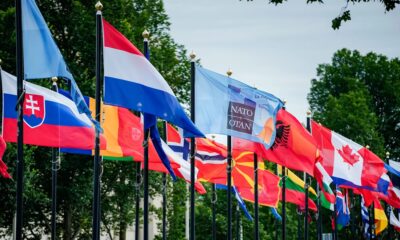
 Diplomacy2 weeks ago
Diplomacy2 weeks agoNATO summit focuses on arms race in the Silicon Valley age
-

 Europe2 weeks ago
Europe2 weeks agoIsrael-Iran conflict postpones EU plan for Russian oil sanctions
-
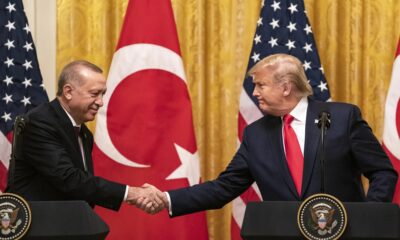
 Diplomacy2 weeks ago
Diplomacy2 weeks agoErdoğan to meet Trump at NATO summit to mend relations
-

 Diplomacy2 weeks ago
Diplomacy2 weeks agoIranian foreign minister travels to Moscow for Putin talks after US strikes
-

 Europe2 weeks ago
Europe2 weeks agoGermany to expand military with 11,000 new personnel this year
-
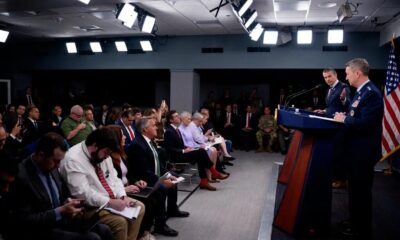
 America2 weeks ago
America2 weeks agoPentagon divided over military priorities in Asia and the Middle East
-

 Middle East2 weeks ago
Middle East2 weeks agoUS bombs Iranian nuclear sites, sparking fears of wider conflict
-
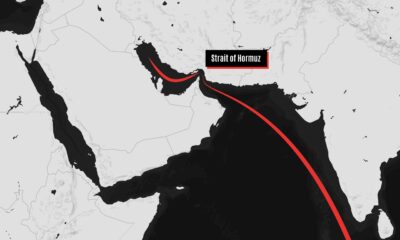
 Asia2 weeks ago
Asia2 weeks agoUS cries to China as Washington begins airstrikes in Iran


